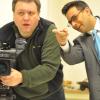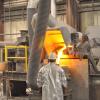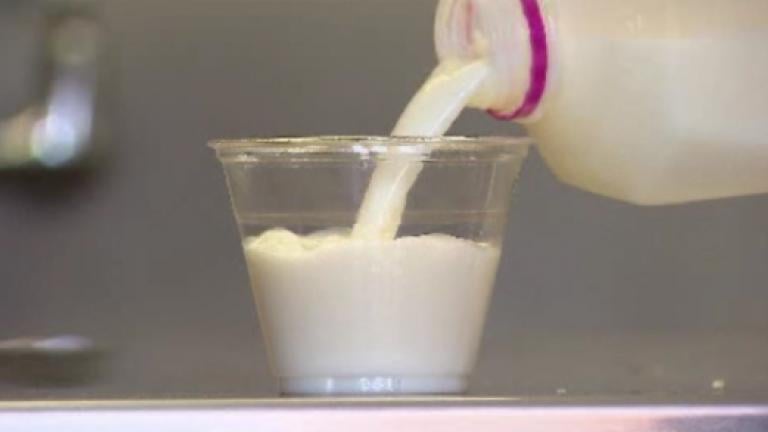Even in a down economy with unemployment here hovering around 10 percent, Central Illinois-based Excel Foundry & Machine has a problem: it has jobs it can’t fill.
Excel makes after-market parts for open pit mining equipment. With a workforce of about 300 and an expansion in the works, the company currently has 50 openings, most of which are high-skilled. But Excel says there aren’t enough trained or interested people in the area to fill the positions.
Here’s a behind-the-scenes look at how packages like this one get made.
Production began more than a month ago after correspondent Ash-har Quraishi and I read an article about Excel in a local newspaper. The PBS NewHour, which runs some Chicago Tonight packages, was interested in a story about manufacturing in the Midwest and staff here had been hunting for an interesting angle.
A line in that Excel story stood out. The article focused on politicians, including Gov. Pat Quinn, announcing Excel’s $15 million expansion, which would create 100 jobs. But CEO Doug Parsons also said they had jobs to fill immediately too: “If I have one message, it's that we want to talk with anyone interested in a job. We've got new machines coming in, and we need people to run them.”
After calling Excel to double check the quote and to get some figures on how many jobs were open and how much they paid, it seemed like Excel would be a great example of something many manufacturers were dealing with; and their foundry and factory floor would provide some compelling visuals.
The next week was spent pre-interviewing, researching, and booking interviews. Before we go on location to shoot a package, we want to be sure we have as much information as possible and know who the key characters are. We knew we wanted to talk to Excel’s Parsons, and also learned Excel was partnering with a local community college to train incoming workers. We arranged to meet the school’s industrial arts dean and visit some classes.
Because Pekin is a three-hour drive from our studios, the shoot would take place over two days: Illinois Central College one afternoon and Excel Foundry the next morning. Overnight bags in tow, photographer Mike Prendergast, Ash-har and I piled into a WTTW van on a Monday morning.
Dean Michael Sloan greeted us at Illinois Central College and showed us around the school. Even though the school wasn’t training any Excel employees until March, we stopped by a few classes to talk to students. We visited a welding class, where a dozen or so students used bright blue blowtorches to make metal joints, some tossing their mistakes into a pile of junk steel. It was all great b-roll (any footage that isn't an interview): sparks flying, engaging teachers and humming machines.
We also dropped by a few other classes before finding a quiet room for our interview with Sloan. Usually we shoot interviews in offices, but at the college we had the chance to set up in an electrical engineering classroom, with all sorts of brightly colored gizmos and gadgets in the background.
After we wrapped up that day, we headed back to the hotel and prepared for an early start the following day. Excel’s foundry promised some of the trip’s best footage—it was creating liquid metal after all—but to catch the foundry firing, we had to make to the factory at the start of the first shift around 7:00 am.
We were on the road by 6:00 the next morning, but on the way there, we realized we’d forgotten to write a stand-up, the portion of the segment where Ash-har appears on camera for a few seconds. The stand-up needs to be engaging, but has to be general enough that we don’t have to plan the whole piece around it.
We already had a sense that we wanted the package to start in the factory and introduce its problem, so Ash-har’s stand-up takes place in the factory. The company needs new workers, he says, and is looking for a solution—it would serve as a bridge between the factory and the college.
First up on our tour of the factory was that foundry, and it was everything we were hoping for. Workers had held off pouring the shift’s casting for a few minutes so we could film them setting up. The crew had already set a mold on fire by the time we got there; they pour liquid bronze into a molding to create bores and shafts for mining equipment, but the mold needs to be red-hot for the process to work.
After the glowing, yellow liquid was poured into the mold, we set off for the rest of the factory. We stopped by the computer numerically controlled (CNC) machines that are the focus of the piece—automated machines that lathe products to spec—and an assembly line where drill heads are made from blocks of solid manganese steel. Everywhere we went, Mike set down his sticks to capture yet another clip for b-roll. “Manufacturing just makes for great television,” Ash-har said.
Back in Chicago, it was time to keyword our tapes, or watch the footage and mark at what time relevant quotes or interesting b-roll occur. It’s much easier to write a script when you can pull up the exact quote you need instead of hunting for it, and it makes the editor’s job easier too.
After a night of writing, and approval from our executive producer, it was time to edit the piece, which takes about two days. First, Ash-har records his narration in a soundproof booth, and then we lay down the a-roll—that’s all the things you’ll hear in the package laid out in order on a timeline, including narration, interviews and any natural sound we want to include. Most of the time is spent matching the b-roll of machines and students to match the script, and to make the cuts between them interesting for the viewer.
To check out the finished product—including the video package and final script—click here.












